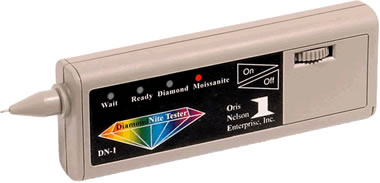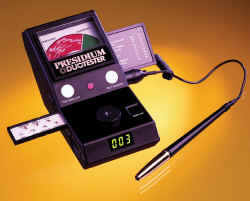|
|
Your Details
|
|
Your Details
|
Reviewed By Andreas Zabczyk
Gemstone TestersWouldn't it be wonderful if there were a simple to use and inexpensive machine that anyone could use to reliably identify gemstsones? One that could distinguish real gems from synthetics and tell you whether your green stone is an emerald, a peridot, a demantoid garnet or just a piece of glass. It would be especially nice if the machine could tell you whether the stone had been heat treated or irradiated. Of course, such a machine should be able to this without damaging the gemstone in any way. 
Unfortunately such a machine doesn't yet exist, and perhaps it never will. But there have been interesting attempts to develop one. There are now some useful devices on the market, though not yet one that can replace the judgement of a trained gemologist using traditional tools. The best attempt so far to design such a device is a diamond tester, which was first used to distinguish diamond from cubic zirconia. Newer versions of these testers can also identify synthetic moissanite. Since these testers work reasonably well on diamonds, there have been attempts to apply the same technology to colored gemstones. They are somewhat useful, but have limitations. Nonetheless, they are starting to be adopted in the trade. 
Gemstone tester operate by assessing the thermal conductivity of materials. Diamonds are particularly notable due to their exceptionally high thermal conductivity, surpassing even silver, the next best heat conductor, by five times. This unique property underpins one of the oldest methods for testing diamonds: placing them against the skin of the upper lip at room temperature. The diamond feels notably cold to the touch because it efficiently draws heat away from the body, a characteristic distinct to its thermal conductivity.. Cubic zirconia has a much lower level of thermal conductivity than diamond, so it was relatively easy to develop a tester to tell them apart. But when moissanite first came on the market, it fooled all the thermal conductivity testers, since moissanite also conducts heat very well. A different test for electrical conductivity had to be incorporated into a new generation of diamond testers. In the world of colored gemstones, current testers on the market such as the presidium gem tester can distinguish sapphire from tanzanite, iolite, spinel, citrine, topaz and tourmaline; and distinguish ruby from spinel and garnet. They can also separate emerald from jadeite and garnet; and distinguish topaz from aquamarine, amethyst and citrine. They can reliably tell you if your putative gemstone is glass, even if they can't always tell you what kind of gemstone it is. To date, no electronic tester even attempts to diagnose gem treatments. Gemologists have no reason yet to fear for their jobs, and at GemSelect we currently offer brief identification reports from your choice of three well-respected independent gemological laboratories, American International GemLab (AIG), International Colored Gemstone Association Laboratory (ICA GemLab) and Burapha Gemological Laboratory (BGL Lab). |
